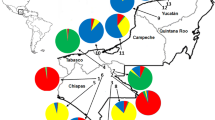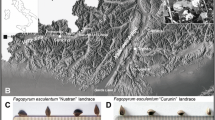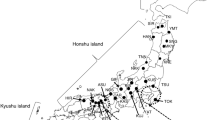Abstract
The phylogenetic relationships among cultivated landraces and natural populations of wild subspecies of Tatary buckwheat were investigated at the individual level by constructing a phylogenetic tree based on RAPD markers. As the PCR templates, DNA of individuals rather than bulked samples, was used. Ten individuals from 10 cultivated landraces, 71 individuals from 21 natural populations of wild subspecies, and 7 individuals from 3 weedy Tatary buckwheat were provided for RAPD analyses. Three groups were recognized: (1) all cultivated landraces and wild subspecies from central Tibet and northern Pakistan; (2) 10 individuals of wild subspecies from northwestern Yunnan; (3) the remaining individuals of wild subspecies from northwestern Yunnan and all individuals of wild subspecies from Sichuan. Group (2) was phylogenetically closely related to group (1). The origin of cultivated Tatary buckwheat, the hybrid origin of weedy Tatary buckwheat and of the wild populations from central Tibet and northern Pakistan are discussed. We arrive at the conclusion that cultivated Tatary buckwheat probably originated in northwestern Yunnan in China.
Similar content being viewed by others
References
Campbell, C., 1995. Inter-specific hybridization in the genus Fagopyrum. Proc. 6th Intl. Symp. Buckwheat, Vol. 1; pp. 255–264.
Innan, H., R. Terauchi, N. Miyashita & K. Tsunewaki, 1995. DNA fingerprinting study on the interspecific variation and the origin of Prunus yedonensis (Someiyoshino). Jpn. J. Genet. 70: 185–196.
Kangfu, Y. & K.P. Pauls, 1994. Optimization of DNA extraction and PCR procedures for random amplified polymorphic DNA (RAPD) analysis in plants. In: H.G. Griffin & A.M. Griffin (Eds.), PCR Technology Current Innovations, CRC Press Inc., Boca Raton, FL. pp. 193–200.
Matsubara, M., 1988. Seizou-kikou (Travels in Qinghai and Tibet). Chuokoron-sha, Tokyo (in Japanese).
Murai, M. & O. Ohnishi, 1996. Population genetics of cultivated common buckwheat, Fagopyrum esculentum Moench. X. Diffusion routes revealed by RAPD markers. Jpn. J. Genet. 71: 211–218.
Nevo, E., B. Baum, A. Beiles & D.A. Johnson, 1998. Ecological correlates of RAPD DNA diversity of wild barley, Hordeum spontaneum, in the Fertile Crescnt. Genet. Resour. Crop Evol. 45: 151–159.
Ohnishi, O., 1994. Buckwheat in Karakoram and the Hindukush. Fagopyrum 14: 17–25.
Ohnishi, O., 1995. Discovery of new Fagopyrum species and its implication for the studies of evolution of Fagopyrum and of the origin of cultivated buckwheat. Proc. 6th Intl. Symp. Buckwheat, Vol. 1, pp. 175–190.
Ohnishi, O., 1998a. Search for the wild ancestor of buckwheat I. Rescription of new Fagopyrum species and their distribution in China. Fagopyrum 15: 18–28.
Ohnishi, O., 1998b. Search for the wild ancestor of buckwheat III. The wild ancestor of cultivated common buckwheat and of Tatary buckwheat. Econ. Bot. 52: 123–133.
Ohnishi, O. & N. Asano, 1999. Genetic diversity of Fagopyrum homotropicum, a wild species related to common buckwheat. Genet. Resour. Crop Evol. 46: 389–398.
Qing, F. C., 1999. A study of resources of Fagopyrum (Polygonaceae) native to China. Bot. J. Linnean Soc. 130: 53–64.
Saitou, N. & M. Nei, 1987. The neighbor joining method: A new method for reconstructing phylogenetic trees. Mol. Biol. Evol. 4: 406–425.
Tsuji, K. & O. Ohnishi, 1998. Phylogenetic relationships among cultivated landraces and natural populations of Tatary buckwheat (Fagopyrum tataricum) revealed by RAPD analyses. Proc. 7th Intl. Symp. Buckwheat Vol. VI, pp. 41–49.
Tsuji, K., Y. Yasui & O. Ohnishi, 1999. Search for Fagopyrum species in eastern Tibet. Fagopyrum 16: 1–6.
Welsh, J. & M. McClelland, 1990. Fingerprinting genomes using PCR with arbitrary primers. Nucleic Acids Res. 18: 7213–7218.
Williams, J.G.K., A.R. Kubelik, K.J. Livak, J.A. Rafalski & S.V. Tingey, 1990. DNA polymorphisms amplified by arbitrary primers are useful as genetic markers. Nucleic Acids Res. 18: 6531–6535.
Zeven, A.C. & P.M. Zhukovsky, 1975. Dictionary of cultivated plants and their centres of diversity. Centre for Agricultural Publishing and Documentation, Wageningen.
Author information
Authors and Affiliations
Rights and permissions
About this article
Cite this article
Tsuji, K., Ohnishi, O. Origin of cultivated Tatary buckwheat (Fagopyrum tataricum Gaertn.) revealed by RAPD analyses. Genetic Resources and Crop Evolution 47, 431–438 (2000). https://doi.org/10.1023/A:1008741513277
Issue Date:
DOI: https://doi.org/10.1023/A:1008741513277




